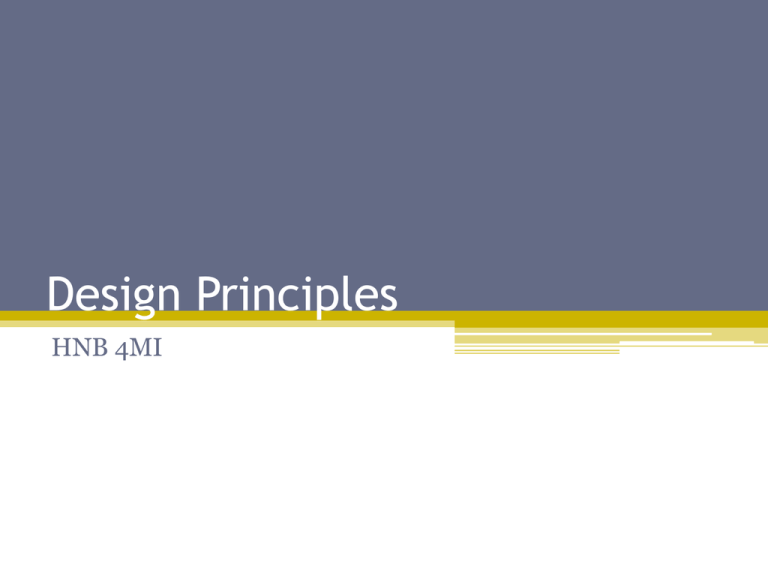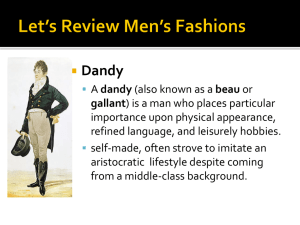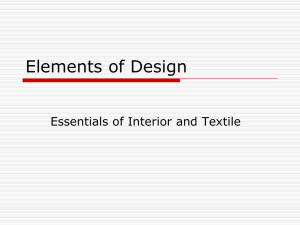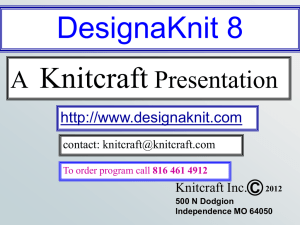Design Principles
advertisement

Design Principles HNB 4MI What makes a good design? Element of Design Principles of Design Silhouette and shape space line texture colour Proportion balance emphasis rhythm = harmony and unity + Good Design Elements of Design: • The elements of design are essentially the building blocks of design and include: • Silhouette/Shape • Line • Texture • Colour Designing garments involves the manipulation of these elements in a manner that is guided by the principles of design. Silhouette • Silhouette or shape is the first characteristic people notice on a garment. • Silhouette refers to a garment's basic shape or outline. • Silhouette can be considered from both a historical perspective, which is still relevant today, as well as an industry perspective. Historical Perspective: 1880s bustle silhouette 1947 bellshaped silhouette Industry Perspectives: These silhouettes represent the five basic shapes used in women's apparel. • • • • • • Bell, or bouffant, or dome shape, The A-line The wedge The hourglass The tubular In women's wear a designer may choose one or two of these silhouettes as a focus for their collection. • The same is not true for men's wear where one silhouette is chosen for a collection and one garment is distinguished from another through the use of different fabrics, detailing, and trims. • Volume and qualities of lightness and weight are closely associated with silhouette. • For example, a sense of fullness and bulk or lack of it is evident in the choice of garment style and silhouette. • As well, use of padding, gathering, heavy, textured, lightweight, soft, and sheer fabrics can give the impression of weight or lightness to the silhouette. • When designing a collection you must always consider the silhouette and shape of a garment from a 360 degree perspective, as the silhouette is not always evident from viewing the front of the garment. • The importance of developing and refining the silhouette cannot be emphasized enough, as it is the silhouette which unifies and helps to develop a theme and focus within a collection. Line • The line of the garment typically refers to the cut and placement of structural lines such as seams and darts, decorative lines such as trims, and added embellishments in a garment. • What is essential to understand about the element of line is that very interesting illusions can be created by using line in specific ways. • For example, vertical and horizontal lines can be used to lengthen or shorten the body while curved lines can give a curvaceous and feminine appearance to a garment. • Designers understand the power of line in creating a visually rich and visually pleasing design. Line Example: Texture: • Designers will often use an identical silhouette and choose identical details for a number of pieces in a collection, the only variation being the texture of the fabrication selected for each garment (Diamnond & Diamnond). • Texture not only affects the appearance of a garment, it also determines the type of fabric manipulation that can occur in the construction of a garment. • For example, garments made from leather and heavy woollen fabrics do not incorporate gathers and draping into the design of the garment. • The fabrication will not respond to such manipulation. Designers know that they must choose a fabrication and texture that will translate into and enhance their design. • Colour is the element of design that has the greatest visual impact without increasing the cost of the garment. • Colour provides symbolism, mood, emotion, excitement, and cohesion to a garment and a collection. • Seivewright (2007) notes that “colour can often be the starting point of a collection and the design process as choosing colours or a colour palette for a collection is one of the earliest decisions you will make when designing a collection” (pg. 128). • It is essential for designers to have a solid understanding of colour and colour theory and how colours can be used and coordinated effectively. Principles of Design: • The principles of design serve as a guide lines for combining elements. Again, the way in which these principles are applied affects the expressive content, or the message of the work. • Balance • Proportion • Rhythm • Emphasis • Unity Balance: • Balance refers to visual weight in design. A garment must be balanced to be visually pleasing. Balance is also the concept of visual equilibrium, and relates to our physical sense of balance. Balance can be achieved in one of two ways: symmetrically or asymmetrically. Symmetrical Balance • Symmetrical balance can be described as having equal "weight" on equal sides of a centrally placed fulcrum. It is also known as formal balance. • In this case the design composition is same on both side of the garment, then the design is considered symmetrical or formally balanced, following the natural bisymmetry of the body. Asymmetrical Balance: • Also known called informal balance. • It involves placement of objects in a way that will allow objects of varying visual weight to balance one another around a fulcrum point. • To achieve a more exciting, dramatic effect asymmetrical or informal balance can be used. • A asymmetrical garment will make pattern layout more difficult as a result are expensive. Proportion: • Proportion is simply the pleasing interrelationship of the sizes of all parts of the garments. • Standards of proportion change with fashion cycles along with the evolution in silhouette and line. • The length and size of design features like pockets, trimmings, surface ornamentation or parts of garments within the silhouettes should compliment the whole. Rhythm: • Rhythm is a sense of movement and is necessary to create interest in a design and carry out the central theme. Rhythm can be achieved by the repetition of lines, shapes and colour to get direction. Emphasis: • Emphasis or a centre of interest draws attention to the focal point of the garment. • It marks the locations in a composition which most strongly draw the viewer’s attention. • A centre of interest should be related to the total structure of the garment. • A focal point can be achieved by colour accents, significant shapes or details, lines coming together, groups of details or contrast. Unity: • A successful design is achieved when all the elements and principles of design work together. • Unity is the underlying principle that summarizes all of the principles and elements of design. • It also the coherence of the whole, the sense that all of the parts are working together to achieve a common result; a harmony of all the parts and at the end to form a successful design. • Image Courtesy: tradenote.net, allwomenstalk.com, thestylesample.com, patternpulp.c sareensaree.com, bridgat.com, pursepage.com References: • Astley, A. (ed.). (2009). The Teen Vogue Handbook: An Insider's Guide to Careers in Fashion. Penguin Group. • Diamnond, J. & Diamnond, E., (1997). The World of Fashion (2nd ed.). Fairchild Publications. Ekstrom, G., Justiss, M. (2006). Fashion Marketing. McGraw Hill. • Fitzgerald, T. & Grandon, A. (2009). 200 Projects to Get You into Fashion Design. Hauppauge: Barron. • Frings, G. (2002). Fashion: From Concept to Consumer (7th ed.). Prentice-Hall. • Newman, C. (2001). National Geographic: Fashion. Washington: National Geographic Society. • Seivewright, S. (2007). Basic Fashion Design: Research and Design. Switzerland: AVA Publishing.











